Spyfall Time Travel is the third installment in the main Spyfall series of games, excluding Spyfall DC, coming from publisher Hobby World. Designed by Alexandr Ushan, the game sees 2 – 8 players whisked through time for around 30 minutes. Featuring artwork from Sergey Dulin, Anton Kvasovarov and Uildrim, this bluffing game takes players to Da Vinci’s studio, a Viking longboat and the battle of Waterloo. However, is this a party game that should be played in the present? Let’s find out!
As with the original, the game of Spyfall Time Travel revolves around the art of bluffing, obtaining information from vague questions and tripping people up – metaphorically of course. Before the game is ready to play, and this only needs to be done once, the deck needs to be split out into the locations. The game comes with enough small plastic bags, so the 8 cards for each unique location can be put in one separately. Gamers can also choose to add a spy card to each bag or keep them separate, with enough included. All of the location sets are then placed face down into the box.
At the start of each round one player randomly draws a location bag from the box. Each card in the plastic bag will show the exact same location, apart from the spy card. Shuffling the spy card with enough location cards, so each player will get a card, players must be careful not to reveal the location. Dealing the cards out, each player gets one card – with noone knowing whom has the spy card or a card that matches theirs with the location on it.
Starting the timer the round begins with one player asking anyone a single questions. While this could be a simple yes or no, like “is it sunny?”, players are free to get creative with both questions and answers. Once they have answered the person questioned then becomes the question giver, asking anyone bar the previous player a question. The trick is not to make the question or the answer to revealing, vagueness is your friend and enemy. The spy starts the round with no knowledge of the location. Either by listening to others’ questions and answers or asking things themselves they slowly build up an idea of where they are.

A game of Spyfall Time Travel can end in a number of ways. At any point any player can pause the game to call a vote. Pausing the timer everyone must unanimously vote for one player to be the spy. If this occurs, that player reveals their card. If the spy has been found non-spies gain a single point, with a bonus point awarded to the the vote caller. If it was not the spy the spy player gains 2 points. Instead, the spy can reveal themselves as the spy. Looking at the list of locations, they then state where they think they are, with a correct guess scoring 2 points. The final way for the round to end is the timer runs out.
The timer is a necessary feature, though one is not included – so a nearby phone can be handy. It forces players not to spend too much time thinking of questions, keeping the game moving constantly. If the timer runs out the voting starts instantly with, again, only a unanimous vote able to find the spy. After a set number of rounds whomever has the most points is the winner. Although, it is more than possible to play without scoring – simply seeing if the spy can blend in each round.
Rather than just doing another sequel the Time Travel theme has rather opened the doors for possible locations and activities occurring on the card art. With everything from the Pyramids being built to a futuristic Tokyo, past Stonehenge, plenty of variety is included. The variation may be the key to making the game look good but it is the small similarities and links that can be made that make the game work. For example the hot air balloon card can easily be confused with the Hindenburg by the spy if the wrong details come out. The card quality is good, and the cards are rarely more than briefly shuffled. This is important, so they don’t easily damage giving specific cards tells to what they are.
Having unique roles on each card adds an additional level of variation, and new lines of questioning, when players are needing it. As the experience grows with players, with the questions and answers used getting better and better, this only helps experienced players take Spyfall Time Travel one step further. Commonly playing with only 6 players (not the full count of 8) also means that not all of the cards from a location set are used. Therefore, even if the same location comes out multiple times the character roles on the cards may not all be the same.

As with the original Spyfall there is one component that is missing from the box. While every location is shown in the centre of the rulebook, a handout of this for each player would make the game significantly smoother to play from the beginning. Rather than new players being left to have little ideas until they glance at the rulebook, potentially giving themselves away, everyone could have something to hand.
The way that the three Spyfall are designed they could easily be combined together to create one large set of locations. The card backs, and even the spy card design, are consistent across the sets. Therefor, players cannot even get an inkling from the card backs as to which set a location was from. For fans of the series this gives a huge boost to replayability, the issue comes when introducing new players. On top of not knowing obvious questions to avoid against experienced players, they’d have to look over an even larger list of locations when choosing as the spy. The answer is an easy one don’t mix with new players but when everyone is ready get combining.
While the original Spyfall has a special place in my collection, Spyfall Time Travel offers something new and different. More tempting than the direct sequel there is an amazing range of periods in history that are included. With such different locations new and creative questions form naturally – many which wouldn’t work with the modern setting of the original. The core gameplay is identical to the rest of the series, which makes it hard to recommend owning multiple sets. Nevertheless, if you are new to the series it is a great place to jump in and fans can use the 30 new locations to spice up their games with experienced players.
(Editor’s Note: Spyfall Time Travel was provided to us by Hobby World for the review at Essen Spiel 2019)

